I finally had time to fix the thread crochet butterfly that I stuffed up a couple of weeks ago!
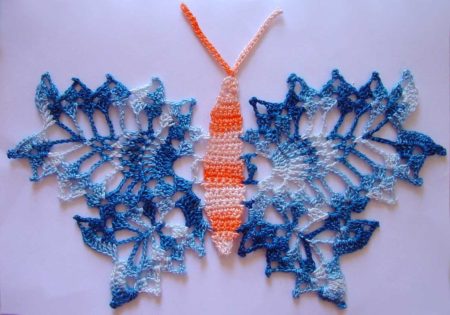
and followed by getting totally carried away making more butterflies 🙂
The first one was meant to be a potholder but I wanted to make it as a decoration so I used slightly finer yarn than the pattern called for. Behold the potterfly!
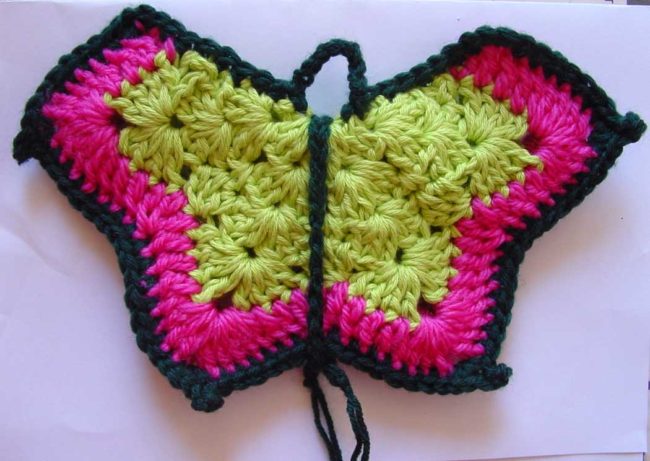
and finally, since you just can’t escape the suffolk puff explosion around here, a suffolk pufferlfy of my own deranged devising.
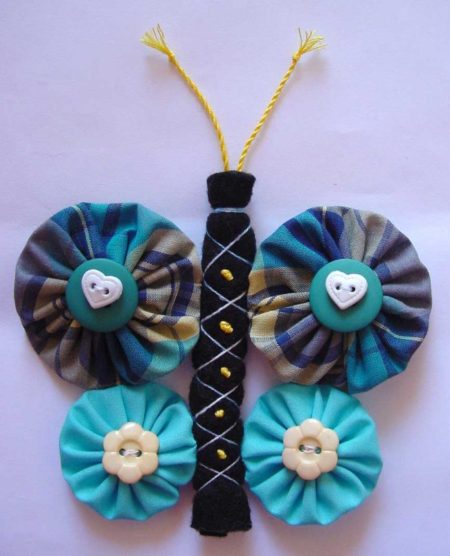
I made the top of the wings with the extra large Clover quick yoyo maker and the bottom with the large yoyo maker. The body is a rolled up strip of felt bound with size 10 cotton and decorated with some french knots.
I’m still playing with hairpin lace techniques. I just found some more patterns in an antique magazine I was looking through last night. Did you know that hairpin lace is also known as hairpin crochet, fork work, krotchee crochet, fourche work, Portuguese lace, Maltese lace and Maltese work? If you’re looking through vintage or antique publications and see references to any of these techniques they may refer to hairpin crochet. Maltese lace and Portuguese lace also refer to bobbin lace and other crochet styles so it depends on the individual pattern. Some patterns just marked as crochet also contain hairpin lacework so it pays to keep your eyes peeled. I had no idea I had so many hairpin lace patterns and techniques in my little collection of antique books and magazines until I read through them all.
Anyway, here’s what I’ve been doing. Since I won’t be adding the hairpin lace section to knitting-and.com until after my brother’s wedding (next Sunday), I’ll put some rudimentary instructions here in the blog for the time being.
First of all, I have come up with a pleasing and extremely simple design for a stole that I want to make for Sunday. (I hope the yarn arrives today!)
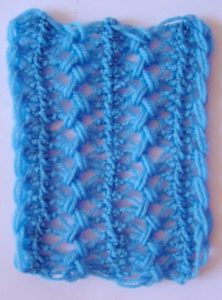
Made with fingering weight yarn on a two and a quarter inch staple.
The strips of crochet are made with the double stitch, meaning you work 2 double crochet (US single crochet) into the front of each loop before turning the fork instead of just one. The hairpin braid is then joined together using the cable join as shown here on the Stitch Diva website, but joining two loops through two instead of single loops as shown in the tutorial.
I’m going to make my stole 6ft long (I’m 6ft tall in flat shoes), with white fingering weight yarn, and as wide as I can make it before I run out of time. I want it to be at least 12 inches wide, I hope to make it 24 inches wide though so I’ll need 12 – 25 strips. Wish me luck 🙂
I also had a go at tree stitch, which is great fun to work and makes a really interesting centre to the braid.
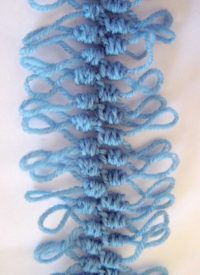
To work tree stitch, work a slip stitch into the front of the large loop on the fork, pass the crochet hook under the front thread of the large loop, yarn round hook and draw through (2 loops on hook), *yarn round hook, pass the hook under the front thread of the large loop, yarn round hook, draw loop through** (4 loops on hook), repeat from * to ** once more (6 loops on hook), yarn round hook and draw through all 6 loops on the hook. Turn the fork and repeat for the next stitch. It’s really important not to forget the slip stitch to start with.
One thing I did find with the Clover hairpin lace tool is that it feels incredibly awkward with any yarn finer than Aussie 8 ply (DK weight). I ended up switching to a Pony brand hairpin staple in size 4 to work with the fingering weight yarn in these samples and immediately found it a lot easier. Next time I get to the newsagent I’ll pick up a pack of large paperclips to see what I can do with those.
I suppose I should sew my skirt while I wait for my yarn to arrive, but first a cup of tea…
